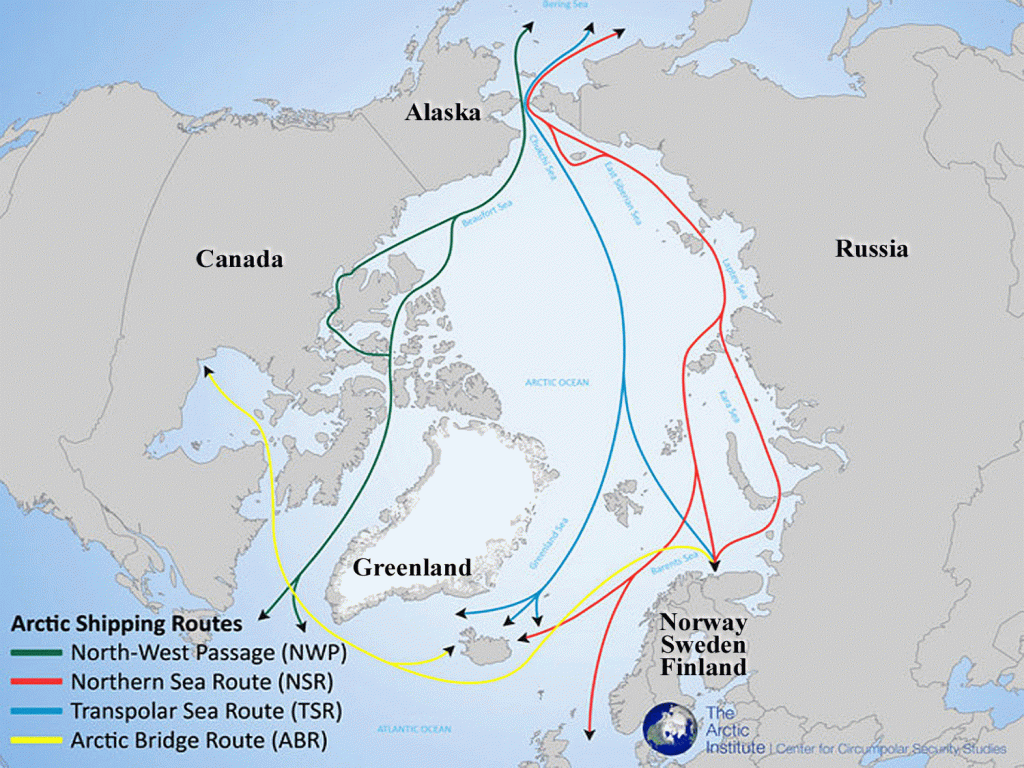China and U.S. Vie for Greater Greenland Presence

The Arctic may not be a chessboard, but China and the United States are maneuvering as if it were. Both nations are working hard to improve their strategic positions. Just in the last few weeks things have heated up, with each looking to build airfields and other points of presence.
As the Arctic continues to melt at an accelerating pace, it’s worthwhile to understand why gigantic Greenland is “ground zero.” Usually my Greenland focus is on its dominant role in global sea level rise, but it’s worth recognizing some of the other aspects of this key Arctic nation that are largely overlooked. So, this will be the first of three blog posts about the northern giant:
- #1 – Today’s Post: Why Greenland Is So Strategic to China and the U.S.
- #2 – Surprising Ways that Climate Change Affects Greenland
- #3 – How Greenland Affects Sea Level and Shorelines Globally
Why Greenland is So Strategic for China
The U.S. has a long history in Greenland with the key presence being the lease of Thule (“Two-Lee”) Airbase in the far north. This is a critical location particularly as it’s the first site to detect potential Russian missiles coming over the pole.
Greenland has many unusual characteristics:
- It is the 12th largest nation, roughly 1,600 miles north to south and a thousand miles east to west, making it roughly the size of the U.S. east of the Mississippi River.
- With just 56,000 residents, it is the least densely populated of all nations.
- It is an independent nation, but part of the Kingdom of Denmark, who assume responsibility for its defense and coast guard.
- Nearly 80% is covered by an ice sheet, averaging more than a mile thick.
- All the towns are on the coast. There are no roads connecting communities. Travel is by boat or airplane, and in the winter months by snowmobile or dogsled.
The map above shows the shipping routes that are becoming more important as the Arctic Ocean melts making possible faster shipping and access to natural resources. The US has Arctic presence (with Alaska and through our agreement with Greenland) along with Canada, Russia, Norway and Iceland. China is absent.
In Anne-Marie Brady’s insightful 2017 book, China as a Polar Great Power, she describes the Chinese global view, with presence in the Arctic being an essential element. In recent years they have established small mining operations in Greenland but have made clear that they want to greatly expand them. As is typical of the Chinese they are strategic and patient.
What would they be mining? Gold, rare earth minerals (needed for modern electronics), and uranium have all been talked about. Some think that such mining is mostly rationale to establish a large community, with a port and airfield. In terms of establishing a strategic presence, that could make a lot of sense. For now, China’s alleged plans for a mining city of five thousand people have been frustrated. Politico published a thorough description of the diplomatic chess game last week, “Pompeo aims to counter China’s ambitions in the Arctic”
In fact, the U.S. is strengthening relations with Greenland in several ways. Secretary of State Mike Pompeo announced that we will open a Consulate in the capital, Nuuk. The Department of Defense said that it will look to develop airfields that have joint military and civilian use — thwarting China’s efforts to build new runways there.
Yet the U.S. is undermining its credibility in the region at the same time. At a meeting last week in Finland of the eight-nation Arctic Council –– Canada, Denmark (Greenland), Iceland, Finland, Norway, Russia, Sweden and the U.S. –– Secretary Pompeo alienated the entire group by refusing to sign a declaration due to some wording that the U.S. administration found objectionable. What was the sensitive language? References to “Climate Change.”
The members were incredulous. It’s impossible to miss climate change in the Arctic, which is warming at twice the global rate. Temperatures are already several degrees above normal as a year round average. One would have to be blind to miss the catastrophic collapse of the great glaciers and the spawning of immense icebergs along with prolific other evidence. More about this next week in Part 2.
One of the hallmarks of chess is that successful players think several moves in advance. As Greenland moves from relative obscurity to prime strategic location, it will present itself as a challenging chessboard indeed. It will be more than interesting to see how the strategies of China and the U.S. are played.
———
I have been to Greenland many times and always come away with new clarity about the changes underway. Each year is visibly different. The glaciers and icebergs are beautiful and powerful beyond description. For anyone who wants a first-hand experience to see the effects of climate change in Greenland up close, I am organizing another exclusive fact-finding trip, September 8-15. For full information and a two-minute video, CLICK HERE.
